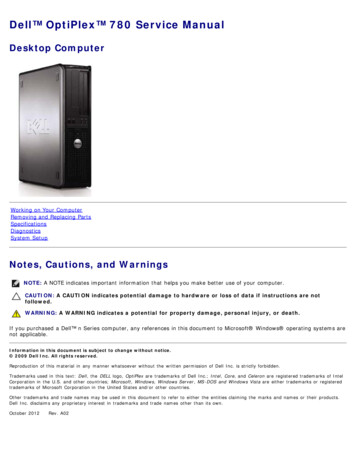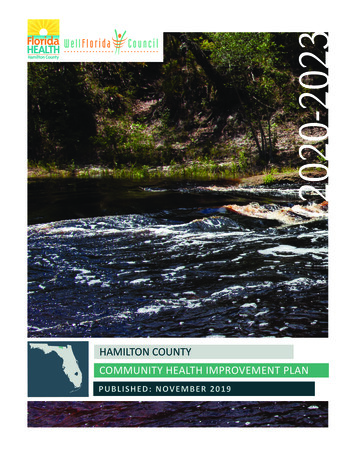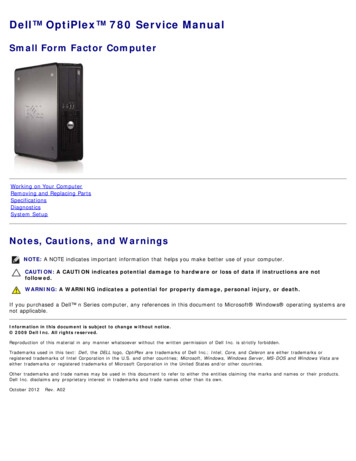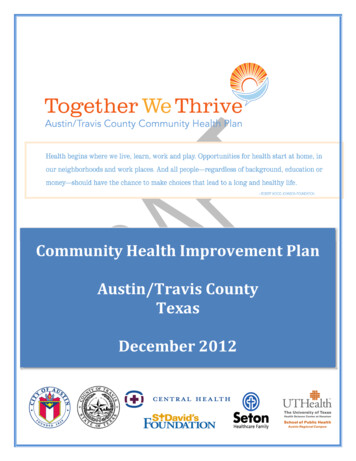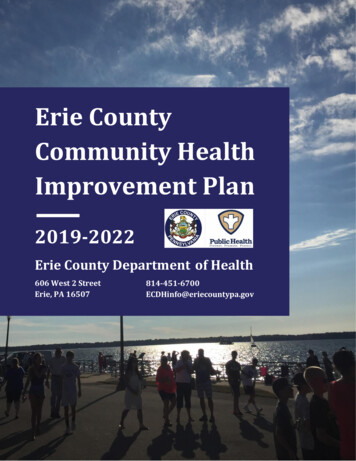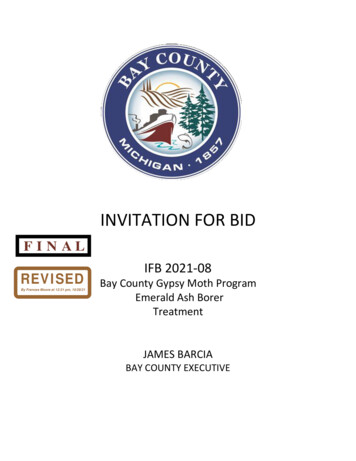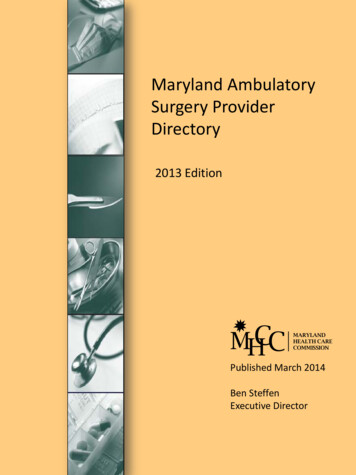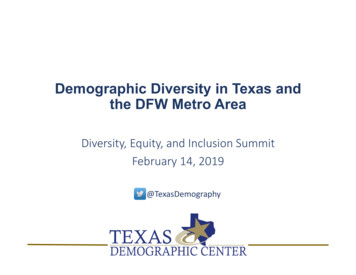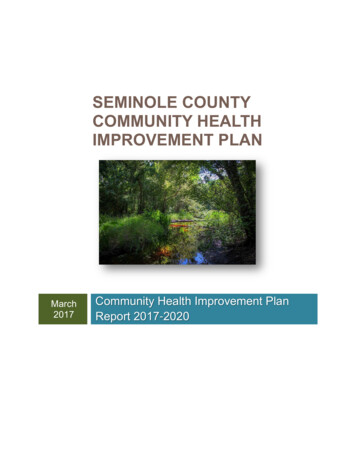
Transcription
SEMINOLE COUNTYCOMMUNITY HEALTHIMPROVEMENT PLANMarch2017Community Health Improvement PlanReport 2017-2020
1ContributorsThe Seminole County Health Profile team was led by CrystalWagner and Donna Walsh.PREPARED BYQuad R, LLChttp://www.quadr.netDisclaimerWhile statistics and data for the indicators were, to the best of the author’s knowledge,current as the Community Health Improvement Plan Report 2017 was drafted, theremay be subsequent data and developments, including recent legislative actions, thatcould alter the information provided herein.This report does not include statistical tests for significance and does not constitutemedical advice. Individuals with health problems should consult an appropriate healthcare provider. This report does not constitute legal advice.For more information, contact Crystal Wagner at the Seminole County HealthDepartment: phone 407-665-3107 or email Crystal.Wagner@flhealth.gov.---DRAFT----Seminole County 2017-2020 Community Health Improvement Plan (CHIP) Report
Table of ContentsLETTER FROM THE DIRECTOR – FDOH-SEMINOLE COUNTY . 4CONTRIBUTORS TO THE COMMUNITY HEALTH IMPROVEMENT PLAN . 6EXECUTIVE SUMMARY. 8INTRODUCTION . 9METHODOLOGY . 11FORCES OF CHANGE . 16Background . 18Methods . 19SWOT . 22Summary/Key Findings . 26STRATEGIC ISSUES . 28Background . 30Methods . 30Strategic Issues . 34Next Steps. 37COMMUNITY HEALTH IMPROVEMENT ACTION PLANS . 38Background . 40Methods – CHIP Session 1 – February 17, 2017 . 40Methods – CHIP Session 2 – February 24, 2017 . 42Action Plans . 44Access to Care . xxChronic Disease . xxMaternal & Child Health . xxMental Health . xxAction Plan Linkages . xxCommunity Health Improvement Plan: Next Steps . xxAPPENDICES . xx1. Forces of Change Workshop – February 3, 2017. xxEmail to Community Health Partners . xxWorkshop Agenda . xxWorkshop Participants . xx2. Forces of Change Workshop Notes . xx3. Seminole County Community Health Resources . xxx4. Strategic Issues Workshop – February 10, 2017. xxx
3Email to Community Health Partners . xxxWorkshop Participants . xxxWorkshop Agenda . xxx5. Strategic Issues Data Sources . xxx6. Strategic Issues Workshop Notes . xxx7. Community Health Improvement Plan – Session 1 – February 17, 2019 . xxxEmail to Community Health Partners . xxxWorkshop Agenda . xxxWorkshop Participants . xxx8. Community Health Improvement Plan – Session 1 – Workshop Notes . xxx9. Community Health Improvement Plan – Session 2 – February 24, 2019 . xxxEmail to Community Health Partners . xxxWorkshop Agenda . xxxWorkshop Participants . xxx10. Community Health Improvement Plan – Session 2 – Workshop Notes . xxx---DRAFT----Seminole County 2017-2020 Community Health Improvement Plan (CHIP) Report
LETTER FROM THE DIRECTORInsert Letter from Donna Walsh
5---DRAFT----Seminole County 2017-2020 Community Health Improvement Plan (CHIP) Report
CONTRIBUTORS TO THE COMMUNITY HEALTHIMPROVEMENT PLANJohnnie AndrewsPatty CaulfieldEmily HallerSeminole County PublicSchoolsFDOH - SeminoleMike BareleyJuley CetouteHugh HarlingWinter Springs RecreationFDOH - SeminoleECFRPCPage BarninghamMirna ChamonoWilbur HawkinsFDOH - LakeFDOH - SeminoleGoldsboro Front PorchDiane BeryCheryl CicottiSierra HelfrichFDOH – Central OfficePreston BoycePeggy CookeDoug HenryFDOH - SeminoleFDOH - SeminoleWalgreensJennifer BeristoMaureen DenizardTodd HustyFDOH - SeminoleFDOH - SeminolePreston BoyceAndrew DerryMeena JosephFDOH - SeminoleFDOH-SeminoleFDOH - SeminoleRufus BoykinTodd DixonDonna KingSeminole IFAS ExtensionAspire HealthFDOH - SeminoleTara BradleyRosana FloresSteven LernerCity of OviedoOrlando HealthSeminole OEMWillie BrownMarie FrancesFDOH - SeminoleCMWPLeslie SueLiebermanRay BruinScott FrybergerBill LittonSanford PDFDOH - SeminoleDebbie CaudillTom KellisAlfredo MaldonadoSeminole County PublicSchoolsFDOH - SeminoleFDOH - Seminole
7Robert McGrawAngie RamajoscSeminole State CollegeCrystal WagnerFDOH - SeminoleJohn MeyerAngie RittenDonna WalshFDOH - SeminoleUCF NursingFDOH - SeminoleVernon McQueenGigi RivadeneyraSara WarrenFDOH - SeminoleFDOH - SeminoleDhanu MistryMelissa McRoryChristine WatkinsFDOH - SeminoleFDOH - SeminoleSSCAFPSusan MulliganAshley RobertsonVenise WhiteFDOH - SeminoleAspire HealthFDOH - SeminoleKen PeachRebecca SharpElizabeth WhittonHealth CouncilMetroPlan OrlandoHenry PenaTania SladeBen WilliamsWalgreensFDOH - SeminoleCity of OveidoDebra PierreNancy SmithKelsi WilliamsCity of OviedoFDOH - SeminoleFDOH - SeminoleAlex QuinteroMirade TaylorSarah WrightMetroPlan OrlandoHSCSCFDOH - SeminoleZeenat RahmanDebra Kater-VracerJean ZambranoFDOH - SeminoleFDOH - SeminoleShephard’s Hope---DRAFT----Seminole County 2017-2020 Community Health Improvement Plan (CHIP) Report
INTRODUCTIONSeminole County CommunityHealth Improvement PlanEXECUTIVE SUMMARYBuilding a healthier Seminole County began as a community-wide initiative with the goalof establishing an ongoing process for identifying and addressing health needs. Theintent of this project was to foster successful partnerships within the community in orderto improve the health of Seminole County residents. The Public Health AccreditationBoard defines a Community Health Improvement Plan (CHIP) as “a long-term,systematic effort to address health problems on the basis of the results of assessmentactivities and the community health improvement process.” A CHIP can be used byhealth departments, as well as other government, education, or human serviceagencies, to coordinate efforts and target resources that promote health.A CHIP serves to address health issues, roles, and common goals and objectivesthroughout the community. The plan can be used to guide action and monitor andmeasure progress toward achievement of goals and objectives. The plan, along with aCommunity Health Assessment (CHA), can be utilized as justification for support ofcertain public health initiatives, as part of funding proposals, and for attracting otherresources toward building programs that improve the overall quality of life of thecommunity.Health Priorities and RecommendationsThe Seminole County Community Health Committee identified four key issues –Chronic Disease Prevention, Healthcare Access, Maternal & Child Health, and Mental(Behavioral) Health - and developed recommendations and action steps. The Task
9Force recommends the Community Health Action Plans should be incorporated into thework of the Florida Department of Health in Seminole County, existing communitygroups, and health care partners.Health Priority: Chronic Disease PreventionGoal:Objective:Health Priority: Healthcare AccessGoal:Objective:Health Priority: Maternal & Child HealthGoal:Objective:Health Priority: Mental (Behavioral) HealthGoal:Objective:---DRAFT----Seminole County 2017-2020 Community Health Improvement Plan (CHIP) Report
INTRODUCTIONThe health status of a community plays a large role in social and economic prosperity,hence it is important that a community strives to continually improve and maintain itshealth. Government agencies (city, county, state) may provide health services; however,successful health programs require an active partnership between all communityagencies.Community health improvement planning is a long-term, systematic effort thataddresses health problems on the basis of the results of community health assessmentactivities, local public health system assessment, and the community healthimprovement process. The resulting Community Health Improvement Plan is used byhealth and other government, educational and human service agencies, in collaborationwith community partners, to set priorities and coordinate and target resources. A CHIPis critical for developing policies and defining actions to target efforts that promotehealth. It defines the vision for the health of thecommunity through a collaborative process andaddresses the strengths, weaknesses, challenges, andopportunities that exist in the community in order toimprove the health status of that community.The Florida Department of Health in Seminole County,working with community health partners, ngcommunity health utilizing the Mobilizing for Action through Planning and Partnerships(MAPP) model. MAPP was developed by the National Association of County and CityHealth Officials (NACCHO), in collaboration with the Centers for Disease Control andPrevention (CDC). MAPP provides a framework to create and implement a communityhealth improvement plan that focuses on long-term strategies that address multiplefactors that affect health in a community. The resulting community health improvement
11plan is designed to use existing resources wisely, consider unique local conditions andneeds, and form effective partnerships for action.METHODOLOGYThe Florida Department of Health in Seminole County and community health partnersmet together for the purpose of evaluating the health status of the citizens of theSeminole County area in order to develophealth improvement interventions. The goal ofthese partners was to develop and ion and wellness programs in theSeminole County area and provide a forumwhere members could join together to plan,share resources, and implement strategies andprograms to address the health care needs ofcitizens.The NACCHO MAPP model for community health planning was used, which provides astrategic approach to community health improvement. This model utilizes six distinctphases:1. Partnership development and organizing for success2. Visioning3. The Four MAPP assessments Community Health Needs Assessment Local Public Health System Assessment Forces of Change Assessment Community Strength and Themes Assessment4. Identifying strategic issues5. Formulating goals and strategies6. Action (program planning, implementation, and evaluation)---DRAFT----Seminole County 2017-2020 Community Health Improvement Plan (CHIP) Report
Community Health Needs AssessmentThe Community Health Needs Assessment provided a “snapshot in time” of thedemographics, employment, health status, health risk factors, health resourceavailability, and quality of life perceptions. Seminole County Health Departmentconducted a Community Health Assessment (CHNA) in collaboration with FDOH-Lake,Orange and Osceola Counties in 2016. Data from the U.S. Census Bureau, includingthe American Community Survey; Florida CHARTS; the Centers for Disease Controland Prevention BRFSS Data; County Health Rankings; and hospital utilization data wasemployed in the Community Health Needs Assessment. Major findings from theCommunity Health Needs Assessment for Seminole County included: The population of 449,144 residents had a median household income of 57,875 in2014. Nearly 13% of the population was living in poverty in 2014. Slightly under a quarter (23%) of the population is 18 years or younger, with 80.6%of the population White and 12.2% Black/African American. From 2008-2014, the leading causes of death were: 1) Cancer, 2) Heart Diseases,3) Chronic Lower Respiratory Disease (CLRD), 4) Unintentional Injuries, and 5)Diabetes. Seminole County had an upward trend of adults who were obese which followedthat of the state of Florida from 2002-2013. Nearly 27% of adults were obese. Poisoning, falls and motor vehicle (unspecified) comprised the top three causes ofunintentional deaths, though the top two (falls and poisoning) accounted for morethan 59 percent of all unintentional fatal injuries in Seminole County in 2013. Where data were available, there was a general downward trend of insurancecoverage for Non-Hispanic Whites and those between the ages of 45-64 inSeminole County between 2010-2013. The percentage of adults with poor mental health days for 14 or more days of thepast 30 days showed an upward trend in the Non-Hispanic White population, along
13with residents making more than 50k annually, those with educational levels abovehigh school, and those making less than 25k per yearCommunity perceptions of the health care system are a critical part of the MAPPprocess. Community Themes and Strengths were compiled in the 2016 CHNA usingdata from the Community Conversations, Consumer Surveys and StakeholderInterviews. The following themes emerged: Affordability of healthcare Need for/access to mental health services Inactivity Due to physical pain or poor emotionalhealth Need more/better bike- and pedestrianfriendly infrastructure Concerns about substance abuse Food insecurity Access to quality/nutritious foods Chronic conditions of concern: diabetes, obesity Need more affordable housing Inappropriate use of ERThe following key findings for the Forces of Changes were compiled in the 2016 CHNAusing data from the Stakeholder Interviews and Provider Surveys: Rise in use of vapes and e-cigarettes Lack of Medicaid expansion Increased heroin use Population growth Affordability of healthcare Human trafficking---DRAFT----Seminole County 2017-2020 Community Health Improvement Plan (CHIP) Report
COUNTY LEVEL COLLABORATION THEMES Diabetes Heart disease Mental health Cancer Homelessness/affordable housing Poverty Food security Access to care Prematurity/infant mortality Asthma Senior safety and mobility Poor transportationLocal Public Health System AssessmentThe National Public Health Performance Standards (NPHPS) Local Public HealthSystem Assessment (LPHSA) Report is designed to create a snapshot of where thehealth department is relative to the National Public Health Performance Standards. Theinformation from the (LPHSA) serves as a foundation from which the health departmentand community health partners can progressively move toward refining and improvingoutcomes for performance across the public health system.The LPHSA is used as a component of Community Health Improvement Planning(CHIP) processes. The self-assessment by community health partners is structuredaround the Model Standards for each of the ten Essential Public Health Services,(EPHS). The Seminole County LPHSA was conducted on December 13, 2016.Community health partners were invited to attend via email and phone calls. Quad R,LLC was contracted to facilitate the LPHSA. The assessment session was held at thelocal food bank, Harvest Time International, with 33 participants from a variety ofhealth agencies, including the local health department, behavioral health agencies, local
15city government departments, community representatives, hospitals, health services,and other agencies participating.The overall scores for each Public Health Essential Service are presented in the chartbelow. The LPHSA rates the local public health system’s performance from OptimalActivity (76-100%) to No Activity (0%). Based on the discussion and ratings, theSeminole County local public health system received high scores in the areas ofEducate/Empower (100) and Develop Policies/Plans (89.6). These ratings indicate theSeminole County local public health system has optimal activity or performance in thesespecific areas. The areas of Monitor Health Status (58.3) and Research/Innovations(55.6) received the lowest performance scores. However the rating levels fall within thesignificant activity level. It is important to note there were no Essential Serviceperformance areas on the LPHSA rated less than 50% or as having moderate, minimal,or no activity.Summary of Average ES Performance Score0.0Average Overall Score72.7ES 1: Monitor Health Status58.3ES 2: Diagnose and Investigate20.040.060.080.0100.0ES 3: Educate/Empower72.2ES 4: Mobilize Partnerships75.0ES 5: Develop Policies/Plans89.6ES 6: Enforce Laws72.2ES 7: Link to Health Services75.0ES 8: Assure Workforce61.9ES 9: Evaluate Services67.1ES 10: Research/Innovations55.6---DRAFT----Seminole County 2017-2020 Community Health Improvement Plan (CHIP) Report100.0
February2017Forces of Change
17As part of the Seminole County Community Health ImprovementProject, the “Mobilizing for Action through Planning andPartnerships” (MAPP) a Forces of Change workshop was conductedon February 3, 2017. Thirty-six (36) community health partnersparticipated in the workshop and identified six (6) Forces Change forSeminole County.---DRAFT----Seminole County 2017-2020 Community Health Improvement Plan (CHIP) Report
BackgroundAs part of the “Mobilizing for Action through Planning and Partnerships” (MAPP) projectin Seminole County, Quad R, LLC was contracted by the Seminole County HealthDepartment to facilitate the Forces of Change Assessment workshop on February 3,2017. The purpose of the Forces of Change workshop was to identify what is occurringor might occur that impacts the health of the community and local public health system.A total of 36 individuals attended. Individuals were representative of various socialservice agencies, city/county government, community residents/businesses, not-forprofit organizations, and other public health system agencies. Participants representeda cross‐section of the community and input provided was based on their knowledge,awareness and perceptions of related health concerns with Seminole County. The list ofparticipants can be found in Appendix 1.MethodsNearly two weeks prior to the scheduled Forces of Change workshop, potentialworkshop participants were contacted by e-mail from the Seminole County HealthDepartment regarding the date, time, purpose of the workshops. An online reservationlink was included on the email. The email invitation, agenda, and worksheet are locatedin Appendix 1.The participants were welcomed to the workshop by the Seminole County HealthDepartment Administrator, Ms. Donna Walsh. After reviewing the agenda, the facilitatorthen asked participants to complete the Forces of Change Brainstorm Worksheet.Participants introduced themselves and their agency to the larger group. The Forces ofChange was explained to participants by the facilitator as an attempt to answer thefollowing questions for Seminole County: "What is occurring or might occur that affectsthe health of our community or the local public health system?" and "What specificthreats or opportunities are generated by these occurrences?"
19The six force categories - Economic, Environmental, Health, Social, Political, andTechnological – were placed on flipchart paper around the room. The facilitator hadparticipants number off and go to a designed Forces of Change category. Using theForces of Change worksheet, participants engaged in brainstorming aimed at identifyingforces—such as trends, patterns, or events—that are or will be influencing the healthand quality of life of the community and the local public health system. The forcesidentified through this process, together with the results of the other three MAPPAssessments, would serve as the foundation for the next MAPP phase—IdentifyStrategic Issues. Workshop participants were reminded to identify local, regional, stateand national forces that may affect the context in which the community and its publichealth system operate within Seminole County.Each group of participants workedcollaboratively to identify health issuesand/or community needs related totheir specific category or “Force.”Participants then moved to each of theflipcharts or “Forces” and addedadditional trends, patterns, or eventsfor that specific Force. The facilitatorthen instructed the workgroups to prioritize the “Force” items based on those items mostimpacting the health of the Seminole County community. A nominal group techniquewas used giving each workgroup a total of six votes for the top items across all sixForces. The Forces of Change work can be found in Appendix 2. The top “Force items,”their respective category, and the number of votes (indicated by *) are on the followingpage:---DRAFT----Seminole County 2017-2020 Community Health Improvement Plan (CHIP) Report
Economic ForcesEnvironmental ForcesHealth Forces*** Cost of health care ** Cost of livingdisproportionate towages* Low/fixed income (s.s.),seniors/disability* Aging population* Foreclosures* Social security – folkscan’t retirePolitical Forces*** Clean water** Increase in traffic* Housing/County-wide* Food availability* Zika (Diseases)**** Access to care** Shift from sick caresystem to preventivebased system* Overweight & obesity* Lack of resources forbehavioral healthSocial ForcesTechnological Forces*** Access/jobs, education*** Health literacy*** Elected officials* Prevention vs Treatment* Trust in Politics &* Family supportGovernment* Board regulatory function* Cut from Public Health &Prevention fund*** Impact of technology*** Education** Telemedicine** Distracted use ofdevices* ConfidentialityWorkgroups then were instructed to review their top or priority Forces for their area, andidentify any resources that could “Help” or “Hinder” efforts to impact those specificitems. The workgroups then reviewed the work of all the groups and added additional“Help” or “Hinder” items.After a break, participants were asked to re-number and placed into five workgroups.This was done so as to enhance the sharing of information, prevent Group Think, andallow for networking across agencies and organizations. During this phase of theworkshop, a Strengths, Weaknesses, Opportunities, and Threats (SWOT) and aResource assessment were conduct. Four of the workgroups were assigned to aspecific SWOT, and the fifth workgroup was directed to the Resource area. Theworkgroups were instructed to identify the Strengths, Weaknesses, Opportunities, orThreats within the Seminole County community which could be used to impact each ofthe six Forces. The facilitator asked the participants to identify people and/or community
21groups, policies, laws, and/or regulations, and physical resources and assets whichcould be mobilized to impact the specific Force. In addition, workgroups were asked toinclude regional, state, and national SWOTs.The Resources workgroup was tasked with identifying the available people, processes,and products that could assist with addressingthe Forces, build on the “Help” factors for eachForce, and overcome the “Hinder” factors.This workgroup was reminded to includecounty, regional, state, and national people,organizations, policies, physical assets andresources.The facilitator then instructed the workgroups to review the work of the otherparticipants. Participants were reminded that items identified as Strengths could alsobe a Weakness, Opportunity, or Threat. The workgroups reviewed each SWOT andResource flipchart and added items. The Resources assessment is located in Appendix3. The SWOT is presented on the following pages:---DRAFT----Seminole County 2017-2020 Community Health Improvement Plan (CHIP) Report
STRENGTHS Diversityo Religions, ethnicitieso Celebrate different cultures (festivals, etc.)o Historic black communitiesPartnershipso Wide range of ethnic restaurants, hospitals, schools,municipalities, community resources, non-profits,CBOs, mental health, ELCsSize of countyo Medium/large/metroo Size of gover’t more manageable & visibleOpportunities & resourceso Close proximity to major universityo Cultural eventsLess bureaucracyo More cooperation among municipalitiesPark system strong: city & countyo Sense of communityo Strong collaborationo Diverse programs for all age groupsGood ratio of PCPS to populationLarge numbers of clinics, hospital systemsHigh rate of college educated individualsIndustries that relate to development of health caretechnologyStrong public school program (rated #2 in state)Easy access to WIC, nutrition & breastfeeding educationHealth Dept. & school system is strong Schools & parks & recreation facilities work well togetherCommunity leaders & officials are open to beingeducated in health Good emergency alert system (Alert Seminole)Free fitness classes through Health Dept. & WestsideCommunity CenterFlexible resourcesExpanding airportIncrease Business opportunity (i.e. Triple A, Verizon)Quality of life longerStrong partnership among all /CCT)Seminole County is top 5 – RWJF health rankingsTechnology – need educationLack of nurses in the schoolso SPNs kidso Ratio – student nurse/studentsInfant mortality Seminole (Black rates )Homelessness Pockets throughout – but on declineAffordable housing Safe neighborhoodsSeminole County’s bureaucracySchool zoning spilt some community – 3 elementaryschools in WinwoodEmergency response times are quickCounty emergency management have good networks,drills, exercises & are well –prepared
23WEAKNESSES Gaps in access to careVolunteers experiencing service fatigue”Tapping same resources (volunteers)Shortage of all healthcare professional (private practices)Cost of medical malpractice limiting healthcare workforceGrant writing skill sets & organizational capacity formulagrants to competitiveLack of resources - , transportation, facilities, time/staff.Community engagement/volunteers (lack of )Health ed/literacy – added to curriculum SCPSLack of care coordinators assisting with patients releasedfrom ER/hospitals Increasing interdisciplinary involvement – creating &building relationshipso Goldsboro, Geneva, Chuluota, WinwoodWork with Brighthouse/Spectrum to provide internet tofamilies in need (FIN program – lack of technologyLack of sidewalks (Sanford, Winter Springs, Edgemon,Goldsboro, Winwood, Geneva, Chuloota)Food desert (Goldsboro)Insurance affordableo Medication costo Dentalo Insured employeesTHREATS Funding (Competing priorities, use of funds)Political climate (social profiling)Drug abuseLack of insurance/underinsuredNatural disastersLack of resources (funds, people)Lack of health education/literacyCost of policy changesLack of accessibilityPersonal agenda (hidden)Terrorism (including cyber, bio, agri)Federal policyEmerging infectious diseases Stress & mental illnessTechnology/economyLack of community (personal, school, etc.)IsolationGunsTrust in aut
Seminole State College Angie Ramajosc Crystal Wagner FDOH - Seminole John Meyer FDOH - Seminole Angie Ritten UCF Nursing Donna Walsh FDOH - Seminole Vernon McQueen Gigi Rivadeneyra FDOH - Seminole . (city, county, state) may provide health services; however, successful health programs require an active partnership between all community agencies.
